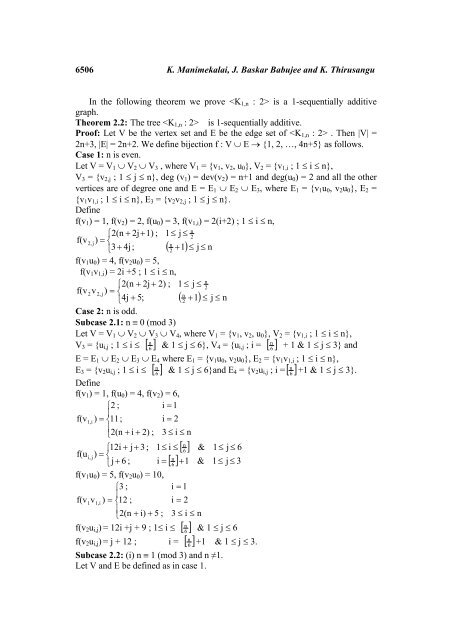Simply Sequentially Additive Labeling of Some Special Trees
Simply Sequentially Additive Labeling of Some Special Trees
Simply Sequentially Additive Labeling of Some Special Trees
Create successful ePaper yourself
Turn your PDF publications into a flip-book with our unique Google optimized e-Paper software.
6506 K. Manimekalai, J. Baskar Babujee and K. Thirusangu<br />
In the following theorem we prove is a 1-sequentially additive<br />
graph.<br />
Theorem 2.2: The tree is 1-sequentially additive.<br />
Pro<strong>of</strong>: Let V be the vertex set and E be the edge set <strong>of</strong> . Then |V| =<br />
2n+3, |E| = 2n+2. We define bijection f : V ∪ E → {1, 2, …, 4n+5} as follows.<br />
Case 1: n is even.<br />
Let V = V1 ∪ V2 ∪ V3 , where V1 = {v1, v2, u0}, V2 = {v1,i ; 1 ≤ i ≤ n},<br />
V3 = {v2,j ; 1 ≤ j ≤ n}, deg (v1) = dev(v2) = n+1 and deg(u0) = 2 and all the other<br />
vertices are <strong>of</strong> degree one and E = E1 ∪ E2 ∪ E3, where E1 = {v1u0, v2u0}, E2 =<br />
{v1v1,i ; 1 ≤ i ≤ n}, E3 = {v2v2,j ; 1 ≤ j ≤ n}.<br />
Define<br />
f(v1) = 1, f(v2) = 2, f(u0) = 3, f(v1,i) = 2(i+2) ; 1 ≤ i ≤ n,<br />
n<br />
⎧2(n<br />
+ 2j+<br />
1) ; 1≤<br />
j ≤ 2<br />
f(v2,<br />
j)<br />
= ⎨<br />
n<br />
⎩3<br />
+ 4j;<br />
( 2 + 1)<br />
≤ j ≤ n<br />
f(v1u0) = 4, f(v2u0) = 5,<br />
f(v1v1,i) = 2i +5 ; 1 ≤ i ≤ n,<br />
n<br />
⎧2(n<br />
+ 2j + 2) ; 1 ≤ j ≤ 2<br />
f(v 2 v 2, j)<br />
= ⎨<br />
n<br />
⎩4j<br />
+ 5;<br />
( + 1)<br />
2 ≤ j ≤ n<br />
Case 2: n is odd.<br />
Subcase 2.1: n ≡ 0 (mod 3)<br />
Let V = V1 ∪ V2 ∪ V3 ∪ V4, where V1 = {v1, v2, u0}, V2 = {v1,i ; 1 ≤ i ≤ n},<br />
n n<br />
V3 = {ui,j ; 1 ≤ i ≤ [] 6 & 1 ≤ j ≤ 6}, V4 = {ui,j ; i = [ 6 ] + 1 & 1 ≤ j ≤ 3} and<br />
E = E1 ∪ E2 ∪ E3 ∪ E4 where E1 = {v1u0, v2u0}, E2 = {v1v1,i ; 1 ≤ i ≤ n},<br />
n n<br />
E3 = {v2ui,j ; 1 ≤ i ≤ [] 6 & 1 ≤ j ≤ 6}and E4 = {v2ui,j ; i =[ 6 ] +1 & 1 ≤ j ≤ 3}.<br />
Define<br />
f(v1) = 1, f(u0) = 4, f(v2) = 6,<br />
⎧2<br />
; i = 1<br />
⎪<br />
f(v1, i ) = ⎨11;<br />
i = 2<br />
⎪<br />
⎩2(n<br />
+ i + 2) ; 3 ≤ i ≤ n<br />
n<br />
⎧12i<br />
+ j+<br />
3 ; 1≤<br />
i ≤ [] 6 & 1≤<br />
j ≤ 6<br />
f(u i, j)<br />
= ⎨<br />
n<br />
⎩j<br />
+ 6 ; i = [] 6 + 1 & 1≤<br />
j ≤ 3<br />
f(v1u0) = 5, f(v2u0) = 10,<br />
⎧3<br />
; i = 1<br />
⎪<br />
f(v1 v1,<br />
i ) = ⎨12<br />
; i = 2<br />
⎪<br />
⎩2(n<br />
+ i) + 5 ; 3 ≤ i ≤ n<br />
n<br />
f(v2ui,j) = 12i +j + 9 ; 1≤ i ≤ [] 6 & 1 ≤ j ≤ 6<br />
f(v2ui,j) = j + 12 ; i = []<br />
6<br />
n +1 & 1 ≤ j ≤ 3.<br />
Subcase 2.2: (i) n ≡ 1 (mod 3) and n ≠1.<br />
Let V and E be defined as in case 1.
















